Llanerfyl is a village situated on the A458 between Welshpool and Dolgellau in Montgomeryshire, near the River Banwy. Within the village is St Erfyl’s church, which contains the remnants of a 15th-century shrine. On the edge of the Churchyard, above the north side of the A458, is the village war memorial, which commemorates all of the local men who served during the Great War of 1914-1918. One side of the monument contains the names of the villagers who lost their lives during the conflict, whilst two sides commemorate those who served and survived.
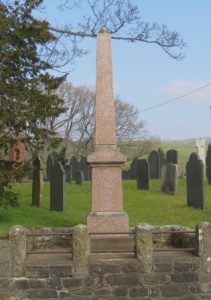
The Great War, 1914-1918
Richard Blainey, Private, 12345, South Wales Borderers. Richard was the son of David and Mary Blainey, of Deunantfach, Llanerfyl. He lived in Cwmparc, Rhondda prior to the war, where he worked as a collier. Richard enlisted into the 4th Battalion, South Wales Borderers at Brecon soon after the outbreak of war. The battalion had been formed at Brecon in August 1914, moving to Park House Camp, near Tidworth to join 40 Brigade, 13th (Western) Division. On 29 June 1915 the division sailed from Avonmouth for Mudros, and on 15 July 1915 landed on Gallipoli, relieving the 29th Division. They left and returned to Mudros at the end of the month, and the entire Division landed at ANZAC Cove between 3 and 5 August 1915, taking part in the Battles of Sari Bair, Russell’s Top, and Hill 60, ANZAC. Soon afterwards the Division was transferred from ANZAC to Suvla Bay, and it was moved from Suvla on 19 December 1915 to the Helles bridgehead, where the Division faced the last Turkish attacks at Helles. On 8 January 1916, the Division was evacuated from Helles, and by 31 January was concentrated at Port Said, where it held forward posts in the Suez Canal defences. On 12 February 1916 the Division began to move to Mesopotamia, to strengthen the force being assembled for the relief of the besieged garrison at Kut al Amara. By 27 March, the Division had assembled near Sheikh Saad and came under orders of the Tigris Corps, and then took part in the attempts to relieve Kut. Richard became ill during the attempted relief, and died of disease at No 39 Field Ambulance, Sheikh Saad on 8 July 1916. The 33-year-old is buried in Amara War Cemetery, Iraq.
Edward Owen Bourne, Private, 55170, Royal Welsh Fusiliers. Edward was the son of Thomas and Mary Bourne, of The Brickyard, Llanerfyl. He worked for his father at the brickyard prior to the war. Edward enlisted at Welshpool into the Montgomeryshire Yeomanry soon after the outbreak of war. He was subsequently transferred to the Royal Welsh Fusiliers, and after completing his training, landed in France in the winter of 1916-17, joining the 2nd Battalion, Royal Welsh Fusiliers, which was attached to 19 Brigade, 33rd Division. During the coming weeks the 2nd RWF received several drafts of reinforcements, and on 8 December the now fully rebuilt battalion moved to new positions at Suzanne, between Bapaume and Péronne. The Division remained in this sector over the coming months, before being transferred to the Arras sector, and reached Henin by 13 April, before the Division took over a section of front line facing the Hindenburg Line. The infantry battalions of the division then began the usual routines of rotating between the front-line, support and reserve trenches and the 2nd RWF took over a position known as Tunnel Trench. On 23 April the 2nd RWF took part in a costly assault on the Hindenburg Line, suffering heavy casualties. The battered battalion then moved to a rest camp at Basseux to rebuild, and by 15 May moved back into the line in the Croisilles Sector. The Division then carried out several assaults against the Hindenburg Line, but could not breach it, so on 27 May 1917 a large-scale assault was carried out again, with the 2nd RWF in the thick of the action. The Division remained in the area until the end of June, when it began to withdraw, and by 5 July had reached Airaines, where it spent several weeks resting. On 31 July the Division entrained for Dunkirk, and moved via Bray Dunes before taking over the front line in the Lombardzyde Sector, on the coast. The Allies were intending to launch a coastal assault here once the main offensive at Ypres had broken through, but following the failure of the latter offensive, the 33rd Division was among several transferred to the Ypres Salient, to help bolster the offensive. By 25 September the Division was in place, and on the following day launched a costly assault on Polygon Wood, suffering heavy casualties. Following a short rest period, the Division moved back into the line, and took part in the final assaults on Passchendaele Ridge. Edward was killed in action near Abraham Heights on 26 November 1917. The 39-year-old is buried in Tyne Cot Cemetery, Belgium.
John Francis, Private, 102419, Machine Gun Corps. John was the son of Robert and Elizabeth Francis, of Glas Yn Craen, Llanerfyl. He worked on his parents farm prior to the war. John enlisted at Welshpool into the King’s Shropshire Light Infantry, but after completing his training, was transferred to the Machine Gun Corps. Upon arriving in France, John was posted to the 114th Company, MGC, which was attached to 114 Brigade, 38th (Welsh) Division. The Division had seen heavy fighting on the Somme, during its assault on Mametz Wood in July 1916. It then took over a section of the front at Hébuterne before moving to the Ypres Salient, and taking over the Canal Bank sector at Boesinghe. The infantry battalions of the Division then began carrying out the normal pattern of rotation in the trenches, four days in the front, four in support and four in reserve, whilst also working on trench improvement, digging new trenches, and also carrying out regular patrols and trench raids. On 31 July 1917 the Division launched its famous assault on the Pilckem Ridge, capturing Iron Cross and reaching its objective of the Steenbeek, then played a supporting role in the Battle of Langemarck. John’s Company had seen heavy fighting during the capture of Pilckem Ridge, and went into reserve on 5 August, moving to a rest camp where a number of drafts helped rebuild the shattered Company. On 17 August the Company moved into the front line, facing Langemarck, suffering several days of intense artillery bombardments. John was killed when his gun team was hit by a shell on 20 August 1917. The 20-year-old has no known grave and is commemorated on the Tyne Cot Memorial, Belgium.
Richard James, Sapper, 503230, Canadian Engineers. Richard was born at Llanerfyl on 29 January 1887, the son of John and Elizabeth James, of Tynycoed. On 31 August 1911 he embarked at Liverpool aboard the SS Canada for Quebec, and found work as a miner. Richard enlisted into the Canadian Expeditionary Force at Calgary on 22 October 1915 and was posted to the 2nd Tunnelling Company, Canadian Engineers. The 2nd Canadian Tunnelling Company was formed in Alberta and British Columbia, before embarking for France, moving to the Ypres sector for instruction. Shortly afterwards, in April 1916, it relieved the 172nd Tunnelling Company, Royal Engineers and began defensive work between Tor Top, Armagh Wood and St Eloi. On the morning of 2 June 1916, the Germans bombarded Mount Sorrel, Armagh Wood, and Sanctuary Wood, and Richard and some fifty other tunnellers took refuge in one of their own tunnels. As the bombardment raged, the exit to the tunnel was blown in, and the men had to dig themselves out. By now the Germans had over-run the Canadian positions, and the tunnellers, along with other comrades working in the area, were captured. Richard was posted as missing on 2 June 1916, and was later found to have been wounded and taken prisoner by the Germans that day. He died of his wounds as a PoW on 7 June 1916. The 29-year-old was originally buried in Gheluwe German Cemetery, but in July 1924 his grave was exhumed, and he was re-interred in Harlebeke New British Cemetery, Belgium.
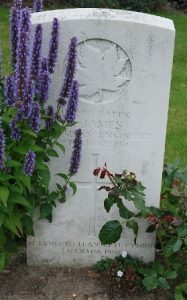
David Thomas Jones, Private, 203546, Royal Welsh Fusiliers. David was the son of Richard and Catherine Jones, of The Cottage, Llanerfyl. He worked as a farm labourer prior to the war. David enlisted into the 4th Battalion, Royal Welsh Fusiliers at Welshpool on 19 February 1916, and was placed on the Army Reserve. He was mobilised on 20 January 1917 and posted to the 4th Reserve Battalion, at Park Hall Camp, Oswestry. Within weeks of arriving at Oswestry, David took ill, and was taken to Oswestry Hospital on 9 February, where he was found to be suffering from catarrhal pneumonia. He died of heart failure in hospital on 23 February 1917. The remains of the 21-year-old were brought home, and he was buried in St. Erfyl’s Churchyard, Llanerfyl.
Meyrick Gordon Jones, Private, 206165, Machine Gun Corps (Motors). Meyrick was born at Verview Villas, Llanfair on 7 May 1886, the son of John Benjamin Jones and Annie Jones. His father was a successful wool manufacturer and by 1901 had become a Hotel Proprietor, after buying The Cann Hotel, at Llangadfan. Meyrick worked at the family hotel prior to the war. He enlisted at Welshpool into the army, and was posted to Coventry, where he joined the Motor Cycle Recruiting Section, before being posted to the Machine Gun Corps (Motors), the early formation of the Tank Corps. After completing his training, Meyrick was posted to D Company, Machine Gun Corps (Heavy Branch), which was in France, equipped with the modern, and top secret, tank. The Company first saw action on the Somme on 15 September 1916, during the Battle of Flers-Courcelette, the very first tank action in history. Meyrick survived the ordeal of the battle, but took ill before being sent to the 1st New Zealand Field Ambulance on 24 September. On the following day he was sent to the 30th Casualty Clearing Section, where he was diagnosed as suffering from with dysentery, and was then sent to hospital at Étaples. He eventually died at Étaples of dysentery on 2 November 1916. The 30-year-old was buried in Étaples Military Cemetery, France.
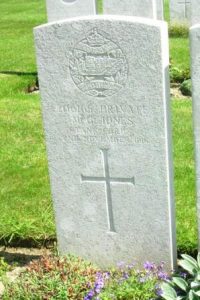
Richard Lewis Jones, Private, 291797, Royal Welsh Fusiliers. Richard was the son of Maurice and Anne Jones, of Caetwpa, Llanbrynmair. He worked as a horseman prior to the war. Richard enlisted into the 7th Battalion, Royal Welsh Fusiliers at Welshpool on 11 December 1915, and was placed on the Army Reserve. He was mobilised on 28 June 1916, joining the 3/7th Battalion, Royal Welsh Fusiliers at Park Hall Camp, Oswestry, and after undergoing his training, embarked for Egypt on 4 December 1916, joining the 1/7th Battalion, Royal Welsh Fusiliers, which was attached to 158 Brigade, 53rd (Welsh) Division. The Division had been evacuated from Gallipoli in December 1915, moving to Egypt to join the EEF, and helped guard the Suez Canal before taking part in operations to drive the Turks out of the Sinai. The EEF then turned its attention onto driving the Turks out of Palestine, and on 26 March 1917 launched its first offensive against the coastal city of Gaza, which guarded the road to Jerusalem. Initial gains during the day were lost when the assaulting divisions lost touch with each other and communication broke down when a thick fog cloaked the battlefield. A second attempt to force Gaza was launched on 17 April, which also failed, and the EEF suffered a change in leadership, with Sir Edmund Allenby assuming command, before being re-organised, and a third offensive was launched against a wider front from Beersheba to Gaza on 31 October 1917. This time the Turkish defences were breached, and the road to Jerusalem now lay open and the EEF began to advance north. On 6 November 1917, 158 Brigade launched an attack on the Khuweilfeh Heights, and once secured, the EEF continued its advance into the Judean Hills, the 53rd Division capturing Hebron and Bethlehem, before securing the Jerusalem to Jericho road. Allenby finally made his triumphant entry into Jerusalem on 11 December. Richard was killed in action during heavy fighting following the Turkish counter-attack, on 28 December 1917. The 32-year-old is buried in Jerusalem War Cemetery, Israel.
Hugh Lloyd, Private, 5777, Royal Welsh Fusiliers. Hugh was the illegitimate son of Ann Lloyd, of Bryn Pistyll, Garthbeibio. He worked as a farm labourer at Llanerfyl prior to enlisting into the Royal Welsh Fusiliers at Wrexham on 22 July 1898. Hugh served with the 1st Battalion, Royal Welsh Fusiliers during the Boer War of 1899-1901, and in 1903 was posted to the 2nd Battalion, Royal Welsh Fusiliers, embarking with the battalion for India the following year. He also saw service in Burma with the battalion, until it returned to England in 1909, and remained with the battalion over the coming years. Hugh embarked for France with the 2nd Battalion, Royal Welsh Fusiliers on 13 August 1914. The battalion was initially placed on Lines of Communication at Rouen, before joining 19 Brigade at Valenciennes, taking part in the retreat to the Marne with the BEF. Following the Battles of the Marne and the Aisne, 19 Brigade moved to Flanders with the BEF, and eventually took over the La Boutillerie sector after becoming attached to the 6th Division. On 19 October the 2nd RWF marched to Laventie, billeting for the night before moving forward of Fromelles, where the men began to dig in. The battalion then moved and dug in a new defensive position around La Cordonnerie Farm, where it was hit by a German attack on 24 October, beating it off with just seventeen casualties. Attacks continued over the coming days, with especially fierce fighting on 26 October, but the battalion stood firm. Hugh was killed during another German attack here on 30 October 1914. The 38-year-old has no known grave and is commemorated on the Ypres (Menin Gate) Memorial, Belgium.
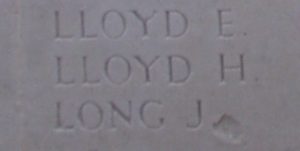
David Morris, Private, 345575, Royal Welsh Fusiliers. David was the illegitimate son of Frances Morris, of Llanerfyl. His mother married David Davies in 1897, and lived at 1, Hazel Square, Llanfair Caereinon. David worked as a farm labourer at Lluest Rhyddfan, Llanerfyl prior to the war. He enlisted at Welshpool into the 3/1st Battalion, Montgomeryshire Yeomanry on 26 April 1916, and was posted to Park Hall Camp, Oswestry, joining the 4th Reserve Battalion, Royal Welsh Fusiliers. On 16 September 1916 David embarked for France, and a week later was posted from the Infantry Base Depot at Rouen to join the 10th Battalion, Royal Welsh Fusiliers, which was on the Somme attached to 76 Brigade, 3rd Division. The battalion had suffered heavy casualties at Delville Wood prior to this, and had a brief spell out of the line to rest and rebuild before moving back into position north of the Ancre, and took part in a gallant attack on Serre on 13 November 1916. David was shot in the head during the battle, and was initially posted as missing. He was then rescued by a stretcher party and treated at the 43rd Casualty Clearing Station before being sent to the 8th Stationary Hospital at Wimereux for further treatment. A week later David was invalided back to England aboard the Hospital Ship St. David, and spent the next three months recovering. On 16 February 1917 he embarked at Devonport for Alexandria, joining the newly formed 25th Battalion, Royal Welsh Fusiliers upon his arrival. The battalion had formed from the merger of the Welsh Horse Yeomanry and Montgomeryshire Yeomanry, as part of the newly formed 231 Brigade, 74th (Yeomanry) Division. The Division assembled in Egypt as part of the EEF, before crossing the Suez Canal into the Sinai, and saw its first major action during the Second Battle of Gaza. The battle was a failure, and the EEF was re-organised under a new commander, Sir Edmund Allenby, before launching the Third Battle of Gaza on the night of 31 October 1917. This assault was launched along a winder front, running from Gaza to Beersheba, and this time the EEF prevailed, opening the door to Jerusalem. Following further fighting in Palestine, the Division was recalled to the Western Front, and arrived at Marseilles during May 1918. The Division trained near Le Cauroy before taking over positions in the St. Floris Sector, moving into the front line between the La Bassée Canal and the River Lys, with the left resting on the small village of Corbie. The Division faced the recently lost town of Merville, some 3,000 yards away. The 25th RWF was in the St. Floris line on 12 July 1918 when David was killed. On the same day, Captain Siegfried Sassoon, serving with the same battalion by now, was wounded in the head. David was 29-years-old when he was killed that day, and is buried in St. Venant-Robecq Road British Cemetery, Robecq, France.
Caleb Owen, Private, 142805, Machine Gun Corps. Caleb was born at Llanerfyl in 1891, the son of Evan and Anna Owen. He worked as a farm labourer at Drum Farm, Llanerfyl prior to the war. Caleb enlisted at Porth, Rhondda into the 8th Battalion, Gloucestershire Regiment in January 1915. The battalion had formed at Bristol in September 1914, moving to Perham Down to join 57 Brigade, 19th (Western) Division. On 18 July 1915 Caleb landed in France with the battalion, and the entire Division then moved to positions near Loos, where it took part in a diversionary attack during the opening day of the Battle of Loos on 25 September 1915. The following year the Division moved to the Somme, where it took part in the second wave of the attack on Ovillers-La Boiselle on 1 July, capturing the village at heavy cost. It then fought through the Somme Battles of Poziéres and the Ancre in 1916. Caleb served in Salonika at some time, as he was reported to have been invalided home, suffering from dysentery. He transferred to the Machine Gun Corps at some time after this, probably upon its formation in March 1918. The battalion was attached to the 1st Division and formed in the Ypres salient. In April 1918 the Division moved south to the Cambrin Sector, taking up positions near the La Bassée Canal, and became caught up in heavy fighting when the Germans launched their offensive along the Lys Valley on 9 April. The Division was bombarded with gas shell that morning, and over the coming days, as the Germans kept attacking. Caleb was killed in action when the 1st Division counter-attacked near Givenchy on 20 April 1918. The 27-year-old is buried in Vieille-Chapelle New Military Cemetery, Lacouture, France.
John Richard Thomas, Private, 291241, Royal Welsh Fusiliers. John was born at Pen Capel, Llanerfyl in 1888, the son of John Thomas and Margaret Thomas (nee Richards). After the death of his father, his mother moved to Henefail, Llangadfan, while John lived at Rhydymeirch, Llanbrynmair, where he worked as a farm labourer. He enlisted into the 3/7th Battalion, Royal Welsh Fusiliers at Newtown on 20 November 1915, and was posted to Park Hall Camp, Oswestry for training. On 26 June 1916 John embarked for Egypt, and joined the 1/7th Battalion, Royal Welsh Fusiliers, which was attached to 158 Brigade, 53rd (Welsh) Division. The Division had been evacuated from Gallipoli in December 1915, moving to Egypt to join the EEF, and helped guard the Suez Canal before taking part in operations to drive the Turks out of the Sinai. The EEF then turned its attention onto driving the Turks out of Palestine, and on 26 March 1917 launched its first offensive against the coastal city of Gaza, which guarded the road to Jerusalem. Initial gains during the day were lost when the assaulting divisions lost touch with each other and communication broke down when a thick fog cloaked the battlefield. A second attempt to force Gaza was launched on 17 April, which also failed, and the EEF suffered a change in leadership, with Sir Edmund Allenby assuming command, before being re-organised, and a third offensive was launched against a wider front from Beersheba to Gaza on 31 October 1917. This time the Turkish defences were breached, and the road to Jerusalem now lay open and the EEF began to advance north. On 6 November 1917, 158 Brigade launched an attack on the Khuweilfeh Heights. John was killed in action during the fighting that day. The 29-year-old has no known grave and is commemorated on the Jerusalem Memorial, Israel. His brother, Roland, had been killed just weeks previously.
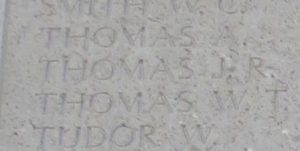
Roland Thomas, Private, 55649, Royal Welsh Fusiliers. Roland was born at Pen Capel, Llanerfyl in 1887, the son of John Thomas and Margaret Thomas (nee Richards). After the death of his father, his mother moved to Henefail, Llangadfan. Roland was married to Mary Thomas, of Frongoch, Llanfair Caereinion. Roland enlisted into the Montgomeryshire Yeomanry at Welshpool, and was subsequently transferred to the Royal Welsh Fusiliers. He was posted to France early in 1917, joining the 10th Battalion, Royal Welsh Fusiliers, which was attached to 76 Brigade, 3rd Division. In May 1917 the Division was at Arras, and fought at the First and Second Battles of the Scarpe, and then at the Battle of Arleux and at the Third Battle of the Scarpe, where the division captured Roeux. On 17 September, after a short rest behind the lines, the Division entrained for Flanders, reaching Gheluvelt the following day. The Division marched through Ypres on 25 September, and crossed the Hannebeke, before taking over a section of the line facing Zonnebeke. At 03.40 on the morning of 26 September 1917, an artillery barrage crashed onto the German lines, then the 3rd Division launched an assault on Zonnebeke, the 10th RWF with orders to follow the initial assault, then advance and take the final objective. As the men crossed the Steenbeek, they lost their bearings, but soon regained their way and reached Zonnebeke relatively unscathed. As soon as the battalion reached the Church, they came under heavy machine-gun fire, and became held up. Roland was killed in action during the fighting near Zonnebeke Church that morning. The 29-year-old has no known grave and is commemorated on the Tyne Cot Memorial, Belgium. His brother, John, was killed in Palestine just weeks later.
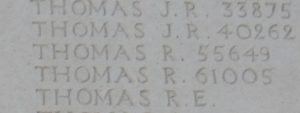
Evan Robert Watkins, Private, 436405, Canadian Infantry. Evan was born at Llanerfyl on 21 March 1891, the son of George Watkins and Abigail Watkins (nee Roberts), of Dolauceimion. He emigrated to Canada some years prior to the war, and worked as a miner. Evan enlisted into the Canadian Expeditionary Force at Edmonton, Alberta on 14 January 1915, and was posted to the 49th Battalion, Canadian Infantry. The battalion embarked for Britain on 3 June 1915, and moved to Shorncliffe, before landing in France on 9 October 1915, attached to the 7th Infantry Brigade, 3rd Canadian Division. The Division moved to Ypres with the Canadian Corps, taking over positions in the south of the Salient. On 2 June 1916 the Germans launched an attack, later called the Battle of Mount Sorrel, and broke through the Canadian lines at Mount Sorrel and Hill 62. The 49th Battalion, in reserve at the time, received orders to move forwards to Belgian Chateau, and came under shellfire at the Ypres Ramparts. After the shelling died away, the battalion continued to move forwards, and reached Sanctuary Wood, where it rested for the night. On the following day the battalion took part in a counter-attack against the Germans, gaining some ground before digging in, and saw heavy fighting during the following day, as it clung onto its gains. On 5 June the 49th Battalion was relieved from the front line, having suffered the loss of almost 400 officers and men. Evan was posted as missing, believed killed in action at some time between 3 and 5 June 1916, following a roll call at Camp C. He had most probably been killed during the assault of 3 June, but the officially accepted date of his death is 5 June 1916. No trace of the 28-year-old was ever found, and he is commemorated on the Ypres (Menin Gate) Memorial, Belgium.
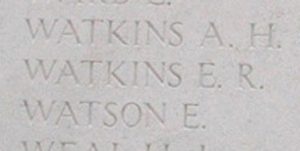
Served and Survived (in alphabetical order)
Astley, J
Astley, Js
Bourne, H
Davies, D
Davies, E
Davies, Ed
Davies, Ed
Davies, E J
Evans, C
Evans, L
Evans, J
Evans, J M
Evans, W T
Gittings, W
Griffiths, J
Humphreys, G A W
James, E C
James, J
James, W
Jones, C
Jones, E
Jones, E
Jones, J
Jones, J
Jones, J
Jones, J R
Jones, R E
Jones, T
Leyworth, C
Morris, E T
Morris, J R
Owen, S
Roberts, J T
Roberts, S
Roberts, T H
Sturkey, W
Terroni, B N
Thomas, D M
Williams, D W
Wynne, T W